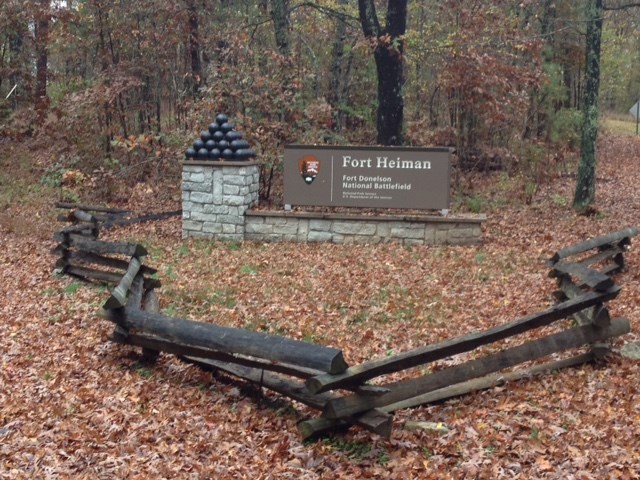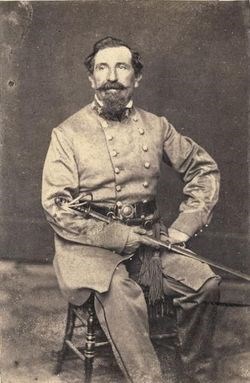
NPS Fort Heiman TodayThe Fort Heiman Unit is located in Calloway County Kentucky. Fort Donelson NB preserves and protects more than 160 acres associated within the area. You'll find earthworks, fortifications built by the Union Army, exhibits, and a small pavilion. For those using GPS or a mapping program, the physical address for the Fort Heiman Unit is 624 Fort Heiman Road, New Concord, KY 42076. You are able to visit Fort Heiman today thanks to the hard work and dedication of many local citizens and partners who care deeply about their history. Recognizing the importance of the land and the stories, the site was added to the National Register of Historic Places on December 12, 1976. In October 2006, the site was included in the boundary of Fort Donelson National Battlefield. 
NPS 
NPS/Andy Thomas 
Tennessee State Library & Archives Fort Heiman in HistoryBy early 1862, as the high waters of the Tennessee River were rising, many Confederates were recognizing that those waters were threatening Fort Henry, their fortification on the east bank of the river. Knowing that an attack by the Federal Army and Navy was not only inevitable, but likely imminent, it was decided that another fortification was needed on the west side of the river. This new fortification, named Fort Heiman, high on a bluff in Calloway County, Kentucky, was named after a famous architect-turned-Confederate soldier, Adolphus Heiman. _________________________________________________________________ "The necessity of occupying these hills was apparent to me at the time I inspected Fort Henry early in November last, and on the 21st of that month Lieutenant Dixon, the local engineer, was ordered from Fort Donelson to Fort Henry to make the necessary surveys and construct the additional works. He was at the same time informed that a large force of slaves, with troops to protect them, from Alabama, would report to him for work, which was to be pushed to completion as early as possible."J.F. GILMER, CSA, Lieut. Col. of Engineers, (written on March 17, 1862) ___________________________________________________________________ NASHVILLE, January 17, 1862. DEAR SIR: I am just starting for Fort Heiman, opposite Fort Henry, where I have been for some time. The general came to Fort Henry on the 15th--and then it was, when I left, debated whether it was not too late to throw up works on the west side, as contemplated by Captain Dixon and every general who knows anything of the position of the Fort. All did concur in the opinion that a failure to occupy the heights would be equivalent to abandoning Fort Henry. JAMES E. SAUNDERS ______________________________________________________________________ [Telegram.]January 18, 1862. General TILGHMAN: Occupy and intrench the heights opposite Fort Henry. Do not lose a moment. Work all night. Johnston _________________________________________________________________ Work proceeded slowly, and this new fortification remained under construction when Federal Brigadier General Ulysses S. Grant launched his offensive in early February, 1862. Starting on February 4, as Grant was landing his troops to the north, Confederate troops were evacuated from Fort Heiman, a process completed by 5:00 AM the next morning. The following day, Thursday, February 6, Federal forces, under the command of Brigadier General Charles Smith, who took possession of an abandoned Fort Heiman. Looking across the Tennessee River, Smith's troops saw the American flag flying at Fort Henry, which had fallen to the Federal gunboats after a brief, yet fierce, fight.Shortly after the victory at Fort Henry, Ulysses Grant ordered Federal gunboats to proceed up the Tennessee River, destroying anything determined to be of military significance to the Confederates. He was also ordered by his superior to hold Fort Henry at all costs. In less than a week, Grant's army proceeded eastward and attacked Fort Donelson. After a fierce naval and land fight, Grant received the surrender of Fort Donelson on Sunday, February 16, 1862. By the end of February, 1862, Nashville was in Federal hands, and the American flag was flying in three former Confederate forts. The Civil War had now entered a new dimension.Federal forces occupied Forts Heiman and Henry for over a year until abandoned in early 1863. During this period, a number of local enslaved men, women, and children sought protection from the Federal forces at Fort Heiman as they were hoping to make a transition from enslavement to freedom. Fort Heiman as Base of Operations for
On October 12, 1864, Confederate General Forrest informed his superior, Lieutenant General Richard Taylor: “It is my present design to take possession of Fort Heiman, on the Tennessee River, below Johnsonville, and thus prevent all communicationwith Johnsonville by transports.” |
Last updated: September 18, 2024

